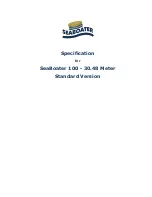
132—Get Ready
DOCKING AND TIE-UP
Docking a boat requires considerable practice to be effective and
avoid damage to the boat. Docking must always be done at slow
speed.
Before attempting to dock, practice in an open body of water. Slow
the throttle to no-wake speed. Shift into neutral and drift slowly to-
ward the dock. If necessary, shift the boat into reverse to further
slow or stop the boat.
Never insert a hand, arm or other body
part between the dock and the boat, or
attempt to keep the boat from hitting
the dock. The boat could push against the dock, pinning the
appendage, and cause severe injury.
The following are recommended guidelines for docking:
• Approach the dock with the starboard side of the boat, if possible.
You will be able to see the edges of the dock and boat better.
• Come to a stop at a short distance from the dock, and then pro-
ceed slowly (no wake).
• Have fenders (where equipped), mooring lines and crew ready.
• Observe how the wind and current are moving the boat. Approach
the dock with the boat pointed into the wind, if possible. If the
wind or current is pushing you away from the dock, use a sharper
angle of approach. If you must approach the dock downwind or
down current, use a slow speed and shallow angle. Be ready to
reverse to stop and maintain position.
• If there is no wind or current, approach the dock at a 10-to-20-
degree angle.
• If possible, throw a line to a person on the dock and have that
person secure a bow line.
• With the bow secure, swing the stern in with a slight throttle and
turning of the steering wheel, or pull it in with a boat hook.
Before tying up the boat, it is advisable to use enough fenders
(an additional, optional purchase) to protect the boat from damage.
It is necessary to tie up with some slack in the line, as tying tightly
will cause the boat’s finish to rub repeatedly against the dock due
to wave or tidal action, but if there is too much slack the side of the
boat may hit (and damage) the finish.
Tie up with the bow toward the waves, if possible, with a
good-quality, double-braided nylon line. Tie up only to the lifting eye
(under the forward bow point) or tie-down eyes (each side of the
transom), or optional cleats. Never use the handrails or windshield
frame, or any other component of the boat. If the boat will be moored
for an extended period of time, use chafing protectors on the lines to
protect the gel coat finish.
When leaving the dock, untie the lines and return them to the boat
deck to avoid snagging on any object on the dock. (Also, stow the
lines so that the operator and any passengers will not trip on the
lines or become entangled.) Move very slowly away from the dock,
unless the wind/current are naturally pushing the boat away from
the dock, where it is possible to drift until safely free of the dock.
Always be certain to visually check that the center and transom
drain plugs are installed and secured prior to deploying the boat in
any body of water. The boat operator must still physically check that
the drain plugs are installed and properly secure.
















































